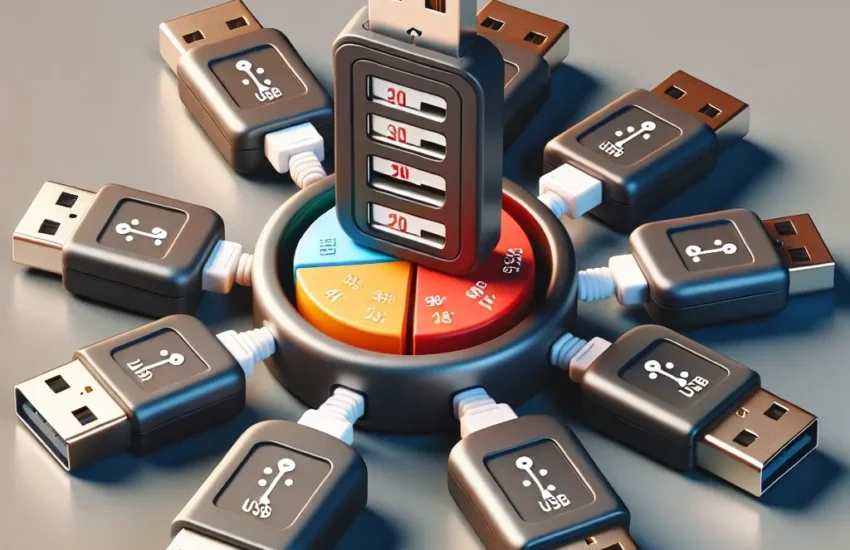Have you ever experienced the frustration of seeing that your flash drive shows a lower storage capacity when used with a USB hub? You’re not alone in this dilemma, as many users have reported similar issues. Understanding the underlying causes can help you manage and prevent these discrepancies. In this article, we will delve into the reasons behind this phenomenon, as well as offer tips on how to avoid such situations in the future.
| Item | Storage Capacity | Conditions |
|---|---|---|
| USB Flash Drive | 64 GB | Used directly in the computer |
| USB Hub | 64 GB | Connected to the computer |
| USB Hub + Flash Drive | Less than 64 GB | Possible data loss or corruption |
Understanding USB Hubs
A USB hub is a device that expands one USB port into several, allowing multiple devices to connect to a single USB interface. While hubs enhance convenience, they can introduce complications. Their primary function is to distribute data and power from a single source, but how they do this can impact the performance and visibility of connected devices.
1. Data Transfer Rates
USB hubs can sometimes limit data transfer rates due to several factors. Not all hubs support high-speed data transfer; some might only support USB 2.0 speeds, which can be significantly slower than USB 3.0. This reduced speed might cause issues that lead to the flash drive showing lower capacity.
2. Compatibility Issues
Using a hub that isn’t fully compatible with your flash drive may result in miscommunication between devices. If the USB hub does not recognize the drive’s full storage capabilities, it can report incorrect available space. This is especially common with older hubs or when using USB flash drives that require more power than the hub can provide.
3. Power Supply Limitations
USB hubs can be powered in two different ways: bus-powered and self-powered. Bus-powered hubs rely on power from the computer, while self-powered hubs use an external power source. If your flash drive demands more power than the hub can supply, it may operate inadequately, which can lead to showing reduced performance or available storage on the drive.
4. Device Overloading
If a USB hub is overloaded with too many connected devices, it can struggle to allocate adequate resources to each one. When multiple devices are connected, the available bandwidth is divided among them, which can lead to a drop in efficiency and perceived storage capacity on your flash drive.
5. Software and Firmware Issues
Outdated firmware or drivers for either the USB hub or the flash drive can contribute to incorrect storage reading. Regular updates to device software can improve compatibility and performance. Always keep your devices updated to minimize issues.
6. Formatting and Partitioning
Sometimes, the way a flash drive is formatted or partitioned can cause compatibility issues with a USB hub. For instance, if the drive is formatted with a file system that the hub doesn’t fully support, such as exFAT or NTFS, it might not display the full storage capacity. Reformatting the flash drive to a more universally compatible option like FAT32 may alleviate this problem.
7. File System Corruption
Corruption in the flash drive’s file system can lead to strange behaviors, including misreported storage capacities. Running a check on the drive to repair any file system errors may help rectify this issue.
Tips to Resolve Lower Storage Capacity Issues
- Connect Directly: Whenever possible, connect your flash drive directly to your computer’s USB port. This ensures optimal performance without hub-related compromises.
- Use a High-Quality Hub: Invest in a reputable USB hub that supports the highest data transfer standards (e.g., USB 3.0 or higher) and has adequate power supply.
- Check Power Supply: If you’re using a bus-powered hub, ensure it’s not overloaded and that it can provide sufficient power to all connected devices.
- Update Firmware/Drivers: Keep your devices’ firmware and drivers up to date to maximize compatibility and functionality.
- Format Appropriately: Format flash drives using widely compatible file systems. Consider using FAT32 for maximum compatibility unless you need features of other file systems.
- Repair Drive: Regularly check your flash drive for errors and repair any filesystem issues promptly.
Conclusion
Seeing a lower storage capacity on your flash drive when using a USB hub can be perplexing, but understanding the reasons behind this issue can help you troubleshoot effectively. By paying attention to compatibility, power supply, and the condition of both the hub and the flash drive, you can optimize your user experience. Remember to keep devices updated and formatted properly to ensure smooth functioning. Adopting good practices while using a USB hub will help you maximize your flash drive’s potential.

